|
Pet Tips
How to keep ants out of your pet's food
How to stop your dog from pulling
How to carry an old dog
Hardwood floors and your old dog
How to build a ramp for your pet
How to build stairs for your pet
How to cut a cat hole in a door
Foods your pets should avoid
How to get cats to drink more
The best litter box
The best litter scoop
Things to do before traveling
More coming, lots and lots more...
______________________________________________________________________________________
How to keep ants out of your pet's food
Time to get medieval. You need
a moat! Simply put a shallow pan (almost anything will do) under your
pet's food dish and fill it with an inch or so of water. Ants and
other bugs will not be able to reach your pet's food dish. You can put
something- a small stick, short rope, maybe a rock- near the edge to help them climb back out should they fall in.
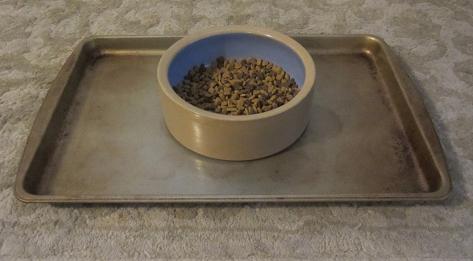
______________________________________________________________________________________
How to stop your dog from pulling
Choke collars don't work without damaging your dog's throat. Ever use one
and heard your dog cough? It's because they will pull against the collar
to the extent that they can take the pain. The trick is to make pulling
less rewarding by changing the angle, let physics work against the dog.
All you need is a basic harness.
| The standard way to attach a
leash to a harness is via the metal ring on the dog's back.
Harnesses are far superior to collars- you can pull your dog out of
traffic, back on the trail, or back into the boat with one, all without
pulling on the dog's neck or head. |
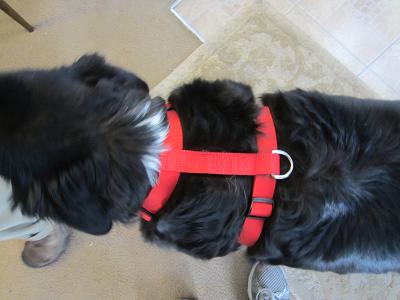 |
| There is a second ring on a
harness, it is where the straps meet by the dog's chest. Attaching
the leash here instead changes the dynamic of pulling- when the dog pulls,
he turns himself sideways. It makes pulling less rewarding, and
doesn't hurt the animal the way a choking collar does. |
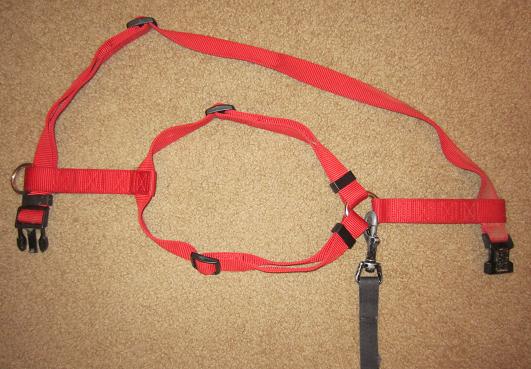 |
______________________________________________________________________________________
How to carry an old dog
Carrying an old dog can be difficult, but a proper hold can make
a big difference.
______________________________________________________________________________________
Hardwood floors and your old dog
Hard floors- wood, tile, etc. are tough on old dogs. The
biggest problem is repeated falling where the dog injures the same area over and
over by falling the same way repeatedly. The simplest solution is to put
down a mat or area rug, but these can be pricey and if the dog has an accident
they can be ruined. Our solution comes from Harbor Freight tools, they are
very inexpensive and durable floor mats that can be configured in many designs
and can be hosed off without worry. We've seen these from $6.99 to $10.99
per 4-pack; Harbor Freight always has coupons online or in magazines,
search for "Harbor Freight Coupon Code". Harbor Freight also has a flat
$6.99 shipping fee for most orders.
| Here's two pieces put together
to make eating easier. They come four pieces to a pack and include
various edge pieces to give it a finished look in various configurations. |
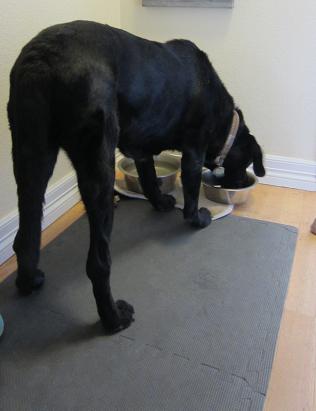 |
| Here are 3 sets put together under some
workout equipment- they're very tough and durable, but also cheap enough
to dispose of when they get gnarly. |
 |
| Item #94635
harborfreight.com |
From Harborfreight.com:
This set of anti-fatigue foam mats gives your aching feet a rest indoors
or out. Waterproof, lightweight and easy to clean, these anti-fatigue
mats lock together in multiple configurations, great for placing in
front of work tables or any area where you might be standing for
extended periods of time. The foam mat set is impact absorbent, adding
both comfort and safety to your work area.
- Impact-absorbing textured nonslip
surface
- Resilient neoprene rubber is waterproof,
easy to clean
- Interlocking squares form multiple
configurations
- 1/2 in. thick
- Each square: 25 in. x 25 in.
|
______________________________________________________________________________________
How to build a ramp for your pet
Stairs can be rough for old pets,
but a ramp can help a lot. We build a lot of these for our customer's
pets. The most important thing with a ramp is to make it as long as
possible to minimize the angle. Secondly, minimize the transitions at
either end by mounting the top as close to level as possible with the next
surface, and bury the low end into the ground or landscaping when you can.
| Basic ramp construction- three
2x4s as the frame, with two cross braces and a diagonal brace on the
bottom. Railing braces are 2x4 as well. Tread boards are cut
fence boards, as are railings. All connections are done with deck
screws and waterproof glue. We prefer to use cedar deck boards with
small gaps rather than a solid board so rain and snow can easily drain. |
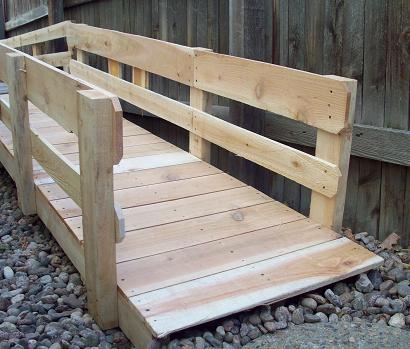 |
| Railing height is determined
by the dog that will be using it. The railing should be squared up
with the meaty part of the dog's shoulder. If your dog is prone to
splaying legs a rail towards the bottom can prevent her feet from sliding
off the ramp- however, it is useful for snow removal to have an opening if
you can. |
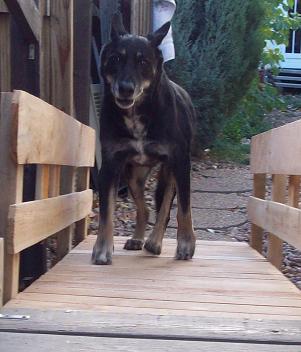 |
| This is how to build the frame
for the stairs. Three 2x4s support the treads, and a Z brace of 2x4s
is added to the underside. |
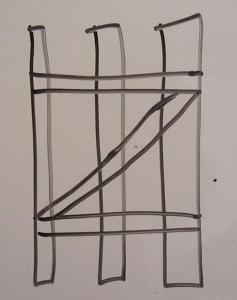 |
______________________________________________________________________________________
How to build stairs for your pet
(with stunning visual graphic aids)
| Stairs have two
components- the tread and the rise. Both of these can be tailored to
your pet's body with two simple measurements. |
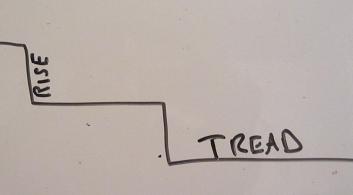 |
| With your pet
standing still, measure the distance between the front and rear feet.
1/2 of that distance is the correct tread length for your pet. |
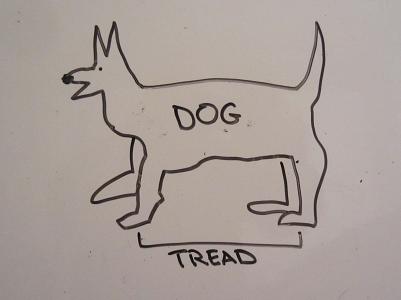 |
| Measure from your
pet's front elbow to the floor. 1/2 of that measurement is the
correct rise height for your pet. |
.jpg) |
______________________________________________________________________________________
How to cut a cat hole in a door
A cat door can be handy for a door
you want to keep closed to keep the dog out or the litter box odor in. To
make a cute mouse-style doorway all you need is a coffee can and a book.
______________________________________________________________________________________
Foods your
pets should avoid:
Alcoholic beverages
Apple seeds
Apricot pits
Avocado- toxic to birds, mice, rabbits, horses, cattle, & dairy goats
Cherry pits
Chocolate (all types)- poisonous to dogs, cats, and ferrets
Coffee
Hops
Macadamia nuts
Moldy foods
Mushroom plants
Mustard seeds
Onions and onion powder
Peach pits
Potato leaves and stems (green parts)
Raisins
Rhubarb leaves
Salt
Tea (caffeine)
Tomato leaves and stems (green parts)
Walnuts
Yeast dough
______________________________________________________________________________________
How to get cats to drink more
You want your cat to drink as much as possible to
avoid renal failure. We see more cats pass from renal failure than
anything else, it is the "old age" disease of cats. The best preventative
is drinking, and here's some ways to do it.
| Tuna Juice- buy tuna in water
and drain the water into a bowl for your cat. You can add a small
amount of additional water as well to dilute it and increase the volume. |
 |
| Extra Water in Canned Food-
you can add a lot of water to canned food, and some cats love it!
Even if you cat won't eat soup like this guy, adding a tablespoon or two
usually goes unnoticed. |
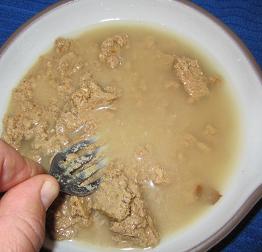
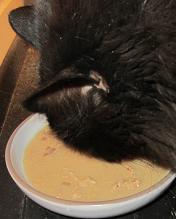 |
| Lactose Free Milk- cats are
lactose intolerant, but if your vet approves, Lactose free milk can be a
good choice for your cat's diet. |
 |
| Fountains- cats like moving
water. There are a lot of different types of fountains, like this
cool egg shaped one that can go inside any bowl. |
 |
| New & Different-
Cats like new things. If you put water in new places, in new dishes
or cups, there is a good chance your cat will try it and hopefully like
it. Sodium-free broths are worth trying too, some cats like them. |
______________________________________________________________________________________
The best litter box
Isn't a litter box at all, it's a cargo box from the
Home Depot. Target and other places carry them too. The sides are
tall so male cats don't spray out, and they have handles built into them that
make them easy to move and carry. We generally don't recommend a liner- to
clean one of these you can put a half gallon or so of hot water with some
cleaner in it, put the cover on and swish it. Then take it outside and
hose it out. Easy! When it gets gnarly dispose of it, or put it in
your alley- for some reason even nasty used ones of these seem to get taken for
reuse.
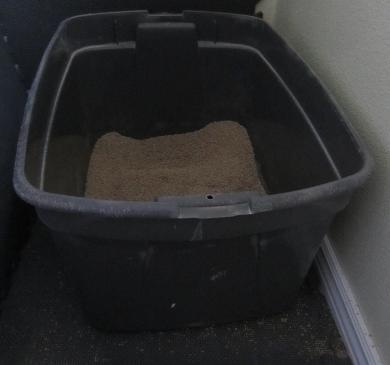
______________________________________________________________________________________
The best litter scoop
We have used them all, the Petmate Ultimate is the
best one. It's well sized and strong with a long handle. Click on
the image for their website; you can buy them at Target, Petsmart, just about
anywhere.

______________________________________________________________________________________
Things to do before traveling:
1. Turn off the water to your washing machine, ice maker, and any other
appliance you can.
The water hoses on these appliances bursting is the number one source of water damage when folks
are away- fortunately, it's easy to avoid! If you don't know where the
shut-offs are, most of the time you can see the hose coming from the appliance
and follow it to the valve. You can buy burst-proof hoses at the
Home Depot for about $30.00. They have built-in flow sensors that shut off
the water in event of a leak.
2.
Leave extra water for your pets.
If you come back later than expected, or a huge snow storm hits, or if the key
you gave your sitter doesn't work, it's good to know your pet has enough water
until someone can make it there. Water is more important than food.
A nice big bowl can give you peace of mind.
3.
Give extra keys.
One set with your sitter, one with a relative or friend that lives close enough
to drive over, and give each the other's phone number; or leave two keys with
your sitter, incase one breaks or fails. We've gotten many bad keys over
the years, especially brand new copies, and a locksmith is about $100.00 to
$150.00, plus wait time can be uncomfortable for your pets.
4.
Use your alarm system, locks, light timers, motion sensors and sprinkler
systems.
These all help protect your home and make it look occupied, both very good
ideas! Detached garages are vulnerable- unplug automatic openers to lock
down the big doors, and lock all windows and doors.
5.
Toys, toys and more toys.
Bored pets do damage- a bag of rawhides, given one per visit over the course of
a vacation, can save your home. Cats love catnip, and will often sleep for
hours after playing in some.
6.
Clean out the fridge, take out the trash.
Old food and old trash stink, try not to come home to them. They also
invite pets to be bad.
7.
Unplug stuff.
Go around the house and unplug whatever you can. We once found a blow
dryer knocked to the floor in a bathroom, running on the high setting; the
guilty cat had been trying to drink from the sink, we think (that rhymed). Fortunately it was only heating up the
side of the tub, but the potential for trouble is there.
8. Tell
your neighbors, family and friends.
Let them know you will be gone, when
you'll be back, and who should be coming around.
9.
Check
your home for the following items, and make sure your pets cannot gain access to
them:
Antifreeze
containing ethylene glycol has a sweet taste that attracts animals but is
deadly if consumed in even small quantities; one teaspoon can kill a seven
pound cat. Look for antifreeze that contains propylene glycol, which is
safer for animals if ingested in small amounts.
Chemicals used on lawns and gardens, such as
insect control products, fertilizer and plant food.
Cedar and other soft wood shavings, including
pine, emit fumes that may be dangerous to small mammals like hamsters and
gerbils.
De-icing salts used to melt snow and ice are
paw irritants that can be poisonous if licked off.
Fumes from nonstick cooking surfaces and
self-cleaning ovens can be deadly to birds. Be cautious when using any
pump or aerosol spray around birds.
Human medications such as pain killers
(including aspirin, acetaminophen, and ibuprofen), cold medicines,
anti-cancer drugs, anti-depressants, vitamins, and diet pills can all be
toxic to animals.
Poisonous household plants include azalea,
dieffenbachia (dumb cane), geraniums, mistletoe, philodendron, and
poinsettia among others.
Strings, yarn, rubber bands, and even dental
floss are easy to swallow and can cause intestinal blockages or
strangulation.
___________________________________________________________________________
Long
Work Days
Vacations
~ Weekends ~ Ski Trips
Business
Trips ~ Holidays
Any
Time!

denver HIGHLANDS EDGEWATER WHEATRIDGE SLOANS LAKE BERKLEY SUNNYSIDE LODO
dog walking ~ pet sitting ~ daily dog walker service ~ cat sitter ~ puppy &
kitten in home care ~ dogs, cats & so much more!
|